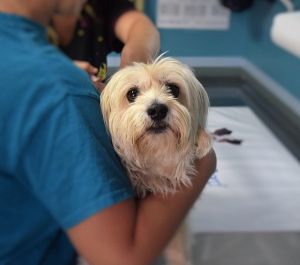Animal Pain Awareness Month: Signs Your Pet Is in Pain
Most pet parents are sure they would know if their pet were in pain, but the reality is that it can be very difficult to tell, even for your veterinarian. Animals have an instinctual drive to hide pain and avoid showing weakness, and they can be very good at it. It is important to stay attentive and get your pet prompt treatment if you suspect they are in pain.
The International Veterinary Academy of Pain Management has proclaimed September as Animal Pain Awareness Month. To support this educational initiative, we want to make sure you are well informed on the topic.

What should you be watching for? There are, of course, some obvious indicators, such as whining, yelping, yowling, crying, and lameness, particularly with trauma and acute injury. Other signs, however, particularly in the case of chronic conditions or early onset of certain diseases, can be much subtler. These include:
Changes in regular habits. Increased or irregular sleep time, loss of appetite (particularly for a pet that has always enjoyed mealtime), less or more water intake, and lack of interest in going for walks or playing with favorite toys can be indications your pet isn’t feeling like themselves.
Changes in behavior. Has your friendly dog become aggressive? Has your lap-loving cat become oddly antisocial? Behavioral changes can be a strong indicator of pain. Avoiding contact, not greeting you at the door, hiding, growling, snarling, defensiveness, and sudden incontinence are all things you should have checked out with your veterinarian.
Physical discomfort. Physical pain doesn’t necessarily manifest in a whimper. Restlessness, inability to get comfortable, difficulty chewing, heavy or shallow panting, bloodshot eyes, dilated or constricted pupils, and changes in posture such as hunching or rigidity could all be signs that your pet is in pain.
Physical changes. Increased heart and/or respiration rate and a rapid weight change—usually weight loss—are strong indicators you have an uncomfortable pet.
Grooming behavior. For dogs, excessive licking can be an indication of pain, an attempt to soothe either an external wound or an area that is painful on the inside—for example, licking a knee after pulling a ligament. Cats, which are normally meticulous groomers, often indicate pain with an absence of grooming behavior.

Keep in mind that while dogs and cats are both good at hiding pain, cats can be particularly talented. A keen eye, knowledge of your pet’s usual habits and behavior, and a willingness to pay attention to the signs your pet is giving you can help you catch an injury or disease quickly and get your pet the help they need.
Treatment Options
Modern veterinary medicine has many options for treating pain in your pet, including medicine, surgery, rehabilitation, acupuncture, and diet changes. If your pet is in acute or chronic pain, a comprehensive exam and a personalized treatment plan from your primary care veterinarian is the best place to start.
If your pet’s pain is severe or worsening during regular business hours, please call your primary care veterinarian first. If it is after hours or they have instructed you to come to The COVE, you do not need an appointment or referral to receive emergency services.
However, please call first if possible—757-935-9111—so that we can best prepare for your arrival and be notified if you need assistance bringing your pet inside.
We will always communicate with your pet’s primary care veterinarian regarding your pet’s condition to ensure continuity of care and appropriate follow-up.
About Us
The COVE’s veterinarians and staff wholeheartedly embrace the core values of community, collaboration, commitment, compassion, and integrity. This focus ensures that pets, the people who love them, and their primary care veterinarians have as positive and affirming a healthcare experience as possible, regardless of the circumstances that bring us all together.
